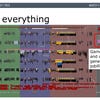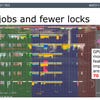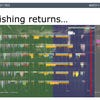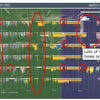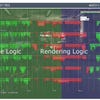The challenge of remastering Uncharted
Why porting the Naughty Dog engine isn't simple - and what to expect from The Nathan Drake Collection.
On the face of it, the notion of bringing the entire Uncharted trilogy from PS3 to PS4 - with 1080p60 upgrades to boot - should be relatively simple. After all, PlayStation 4 represents a generational leap in system capabilities, particularly in terms of raw GPU power. However, Naughty Dog's recent GDC talk - "Parallelising the Naughty Dog engine using fibres" - reveals in stark detail how difficult it was to bring The Last of Us across to the new Sony console. Indeed, the initial porting work for the game resulted in a sub-optimal experience operating at less than 10fps.
In many ways, the scale of the challenge with the upcoming Nathan Drake Collection is even more daunting. Three games are in development, not just one, and the original developer itself isn't carrying out the conversion work - instead, Austin-based studio Bluepoint Games is taking the conn. Adding to the difficulty factor, Sony has dropped hints that the three remasters will actually see tangible improvements over the original versions in the form of "better lighting, textures and models", along with a photo mode, plus other enhancements suggested by the community. Just about the only concession is the somewhat disappointing news that the multiplayer components of Uncharted 2 and its sequel will be removed.
Regardless, The Nathan Drake Collection is a highly ambitious project - and the evidence suggests that the efforts Naughty Dog made into bringing The Last of Us onto PlayStation 4 form the technological foundation on which the remasters are based. So how did the studio turn that initial 10fps port into the slick, 60fps release we enjoyed last year? Based on Naughty Dog's GDC presentation, it seems that the developer was more limited by the CPU, rather than the GPU. The studio leveraged the PS3's Cell chip extensively, in particular the six available SPU satellite processors. The original engine targeted a 30fps update, based on a single processing thread consisting of game logic followed by a command buffer set-up (basically generating the instructions for the GPU). Most of the engine systems were hived off to the SPUs, with the main processor - Cell's PPU - running the majority of the actual gameplay code.
Of course, with PS4, there is no more Cell processor, and thus no SPUs. For PS4's x86 Jaguar cores, Naughty Dog re-architected the way in which code is executed with the introduction of "fibres". Rather than running gameplay code on the main PPU core and hiving out other engine tasks to the SPUs, all processing jobs are run on these fibres - akin to hundreds of threads all assigned to single cores on the PS4 CPU, running massively in parallel. The first problem was plumbing in the new PS4 rendering code Naughty Dog had written - it didn't use the fibre system, resulting in the disappointing initial frame-rate of the initial TLOU port. Integrating the new GPU code into the jobs-based set-up more than doubled the speed of the game, but with three months to go until the product shipped, The Last of Us Remastered still couldn't hit 30fps. As Naughty Dog itself admits, a lot of people were getting worried by this point.
Further optimisations saw Naughty Dog hit the 30fps threshold - but with each frame still taking 25ms to render, the studio was still a long way off hitting the 60fps target, and at this point the team had just two more months of development time until the game was released. However, the theoretical performance was there - the CPU cores still had a considerable amount of left over 'idle' time, so how best to make the most of it?
Naughty Dog's remarkable solution was to cut the entire CPU side of the process in half - while the CPU prepared the GPU command buffers for the next frame, it simultaneously worked on the game logic for the frame after that. The end result sees the 'critical path' of CPU code dropping from 25ms to 15.5ms, the only compromise coming in the form of an additional frame of lag (no problem there - doubling the frame-rate more than makes up the difference). There's a 16.7ms per-frame window for running a game at 60fps: the notion of running different types of processing for two different frames in parallel was the breakthrough that made The Last of Us' 1080p60 gameplay possible. It's a fascinating story - but what relevance does it have to the scale of the task facing Bluepoint Games as it tackles the Uncharted remaster?
Well, bearing in mind that The Nathan Drake Collection is based on games using the same engine - and that a similarly high frame-rate is promised - it stands to reason that Bluepoint Games will be using the same system developed for The Last of Us Remastered. After the months of intense work Naughty Dog put into TLOU, the notion that Bluepoint Games would start again from scratch simply doesn't match sense. On top of that, the inclusion of a new photo mode - an enhancement also found in Naughty Dog's TLOU port - also suggests that there's a fair amount of code sharing going on between the two projects.
At a basic level then, the core logistics of how The Nathan Drake Collection is possible - for an external developer, no less - are in place, and it wouldn't surprise us at all if the viability of the project has much to do with the technological ground work laid by Naughty Dog last year. However, it's interesting to note that even with the GDC talk explaining so much, there's still plenty that we're in the dark about. For example, the GPU rendering side of the equation isn't covered at all, aside from talk of a new renderer and the success of its optimisation. It's also interesting to note that in the final analysis of the shipping game, it does seem that TLOU turned out to be GPU-limited, with transparency effects in particular occasionally hitting frame-rate hard.
What we don't know about the GPU side of the equation may explain how The Nathan Drake Collection is able to boast 'better lighting' compared to its PlayStation 3 equivalents. Perhaps some newer Naughty Dog tech is being deployed on the older Drake titles. Alternatively, it's worth remembering that the studio ported the last - and latest - form of its PS3 engine to Sony's latest console. Lighting and shading improvements made for TLOU could possibly be repurposed for the Uncharted games.
The extent of the lighting enhancements is going to be an interesting element of the new collection. We're curious to see whether it concentrates on dynamic lighting or whether the focus is on the pre-calculated global illumination utilised on the environments. Certainly, properly recalculating the 'baked' lighting would be a computationally expensive task that would require a lot of man hours, not to mention a lot of offline rendering.
Other promised improvements to the Uncharted games certainly seem easier to achieve - there's talk of more detailed models (higher detail versions used for cut-scenes could be injected into gameplay) as well as new textures. The latter enhancement could be particularly welcome - if there's one criticism with Naughty Dog's port of The Last of Us, it's that lower resolution textures really stood out in the pristine 1080p presentation. At the time we pointed out that the game really would have benefitted from an additional parse, with the most obtrusive last-gen elements improved and refined. Maybe that's the case with The Nathan Drake Collection.
Of course, the game that stands the most to gain from any enhancements would be the original 2007 Uncharted release - Drake's Fortune. Naughty Dog's transition across to PlayStation 3 was fraught with difficulties, the studio rewriting the game pipeline and associated tools ten months into full production. Bearing in mind that this was Naughty Dog's first exposure to the challenging PlayStation architecture, the end result - unpolished as it may be in places - was nothing short of a miracle. However, from a technological standpoint, it was easily eclipsed by the two sequels, where Naughty Dog's utilisation of the PS3's SPUs was an order of magnitude more advanced, and where tools and workflow had been given a chance to mature.
In terms of their technological accomplishments, Uncharted 2 and its sequel are a good, matching pair. To what extent the original game stands up to its successors in its remastered form remains to be seen, and it'll be fascinating to see whether Bluepoint invests time and effort in strategic upgrades designed to bring the original game up to par with its sequels. Certainly, one of the most disappointing elements of the first Uncharted's presentation - its screen-tear - was fixed for all of Naughty Dog's subsequent games, and we'd expect that to be the case for the remaster of the original too.
As you can see from the video above, the tearing was extremely intrusive, often manifesting at the centre of the screen, directly in the field of view. We've simulated how the game looks with the tearing removed and the improvement is extraordinary - add on the extra resolution and the much smoother frame-rate and the original Uncharted experience should be well worth revisiting. Our only worry is that some of Naughty Dog's earlier assets may not match the pristine, sometimes unforgiving harshness that a full HD presentation may offer.
In terms of the impact of the 60fps frame-rate upgrade, we've already had a preview of how this transforms the Uncharted experience. In the run-up to the launch of the final game of the first trilogy, a full 60fps gameplay clip emerged from the labs of Naughty Dog - a segment of action we suspect was generated by the studio's 'render farm' of networked debug PlayStation 3s. By rendering the action offline, the studio is able to create screenshots with enormous resolutions (like this 2560x1440 Uncharted 2 "bullshot") or - as seems to be the case here - to double temporal resolution on gameplay.
With The Nathan Drake Collection and PlayStation 4, yesterday's offline render pipe-dream becomes today's real-time experience - and hopefully much more besides. Similar to Halo's Master Chief Collection, we can expect an immense level of expectation with this release. It's unlikely that the remasters will fully satisfy each and every member of Naughty Dog's passionate fanbase - every Uncharted fan will have their own wish list of changes and enhancements they'd like to see in place in the final release. But all of the signs suggest that this 'Master Thief Collection' should tick all the right boxes. The technological underpinnings are already in place, presumably, via The Last of Us Remastered work - and in Bluepoint Games it's clear that Sony has got one of the best, most experienced teams for this kind of task on the job.
The arrival of more last-gen remasters - this one almost two years after PS4's launch - may rankle some, but we can't help but think that these games have more to give in their PS4 incarnations. We love E3 because we get to see a bunch of great new games in action - but with The Nathan Drake Collection hopefully getting an extended gameplay reveal, we're looking forward to reacquainting ourselves with some old friends too.



